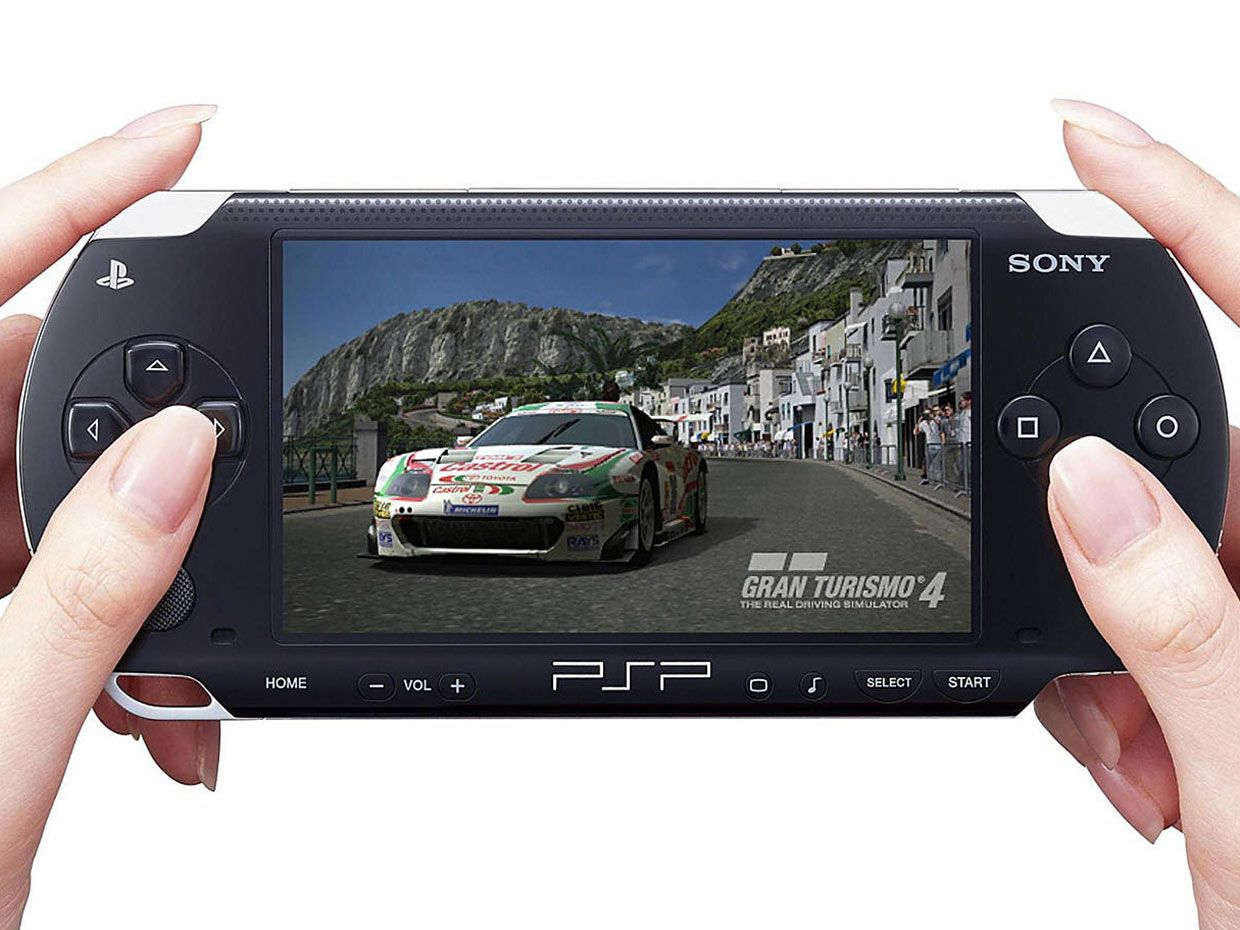The Consumer Electronics Hall of Fame: Sony PlayStation Portable
 Photo: Jiji Press/AFP/Getty Images Mighty Mite: The PlayStation Portable had relatively powerful hardware and a generous complement of software when it was introduced, in December 2004 in Japan.
Photo: Jiji Press/AFP/Getty Images Mighty Mite: The PlayStation Portable had relatively powerful hardware and a generous complement of software when it was introduced, in December 2004 in Japan.  Enter Here < Back to Consumer Electronics Hall of Fame
Enter Here < Back to Consumer Electronics Hall of Fame The PlayStation Portable (PSP) was the labradoodle of the electronic games industry, an odd crossbreed, muscular and fun, but also kind of pricey. The PSP, a combination game system and media player, wasn't the most popular handheld system, but it was a crackling cauldron of surprisingly advanced tech for its time.
Handheld game players had been around for decades. The first ones were dedicated to playing a single game; a popular early example was Mattel's Football, introduced in 1977. Handheld players never went away entirely, but mostly languished until Nintendo came up with a spectacularly winning formula in 2001. The company had already established its credentials with larger console systems, and when it introduced the Game Boy Advance handheld, it already had not just popular games but popular game franchises. The company successfully migrated its Mario, Zelda, and Poki(C)mon series to the Game Boy Advance, which became hugely popular as a result.
In the console market, Sony and Microsoft had been chipping away at Nintendo's dominance for years with PlayStation and Xbox, respectively. But as late as 2003, nobody had managed to provide any real competition to Nintendo in handheld systems.
If anyone could give Nintendo a run for its money there, it was probably Sony. In 1995, Sony had pushed into the U.S. and European console markets with the original PlayStation by offering games that made use of superior graphics, coupled with outstanding multimedia capabilities. (For example, subsequent models of the PlayStation would have the ability to play Blu-ray disks.) It could use the same playbook for a handheld system. The best time to catch a well-established competitor is when the competitor is transitioning from one generation of technology to the next. In 2003, Nintendo was known to be preparing its follow-on to the Game Boy Advance. That year, Sony announced the PSP.
 Photo: Jiji Press/AFP/Getty Images The Competition: The Nintendo DS, introduced a month before the PSP, was the unit to beat in the handheld game-console market. Over a nine-year run, from 2004 to 2013, Nintendo sold about twice as many DSes as Sony sold PSPs. The DS was not as powerful or as versatile as the PSP but it was roughly $50 cheaper, had a larger library of available games, and relied less on proprietary memory and compression formats.
Photo: Jiji Press/AFP/Getty Images The Competition: The Nintendo DS, introduced a month before the PSP, was the unit to beat in the handheld game-console market. Over a nine-year run, from 2004 to 2013, Nintendo sold about twice as many DSes as Sony sold PSPs. The DS was not as powerful or as versatile as the PSP but it was roughly $50 cheaper, had a larger library of available games, and relied less on proprietary memory and compression formats. Nintendo got its next portable, the DS, to the market in November 2004. The PSP debuted in Japan in December of 2004; distribution to North America began a few months later. The Nintendo DS embodied several innovations, the most notable of which was a second LCD screen (this one a touch screen) that worked in tandem with the first. But where the DS was basically just a good handheld game system, the PSP was a new hybrid: a combination game system and media player.
And it was a beast. Designed by a team led by Shinichi Ogasawara at Sony, the PSP debuted as the most powerful handheld on the market, with remarkable graphics capabilities. It was based on a pair of MIPS R4000 microprocessors from MIPS Technologies, which ran at a then-impressive 333 megahertz. One functioned as the central processing unit and the other as a media processor. There was also a dedicated graphics processor, which Sony called the Graphics Core, that ran at 166 MHz. It could handle 24-bit color graphics, about eight bits better than most comparable units at the time. It also had one of the largest screens in the handheld-gaming world, a 480- by 272-pixel thin-film-transistor LCD that measured 4.3 inches on the diagonal. The original version had 32 megabytes of onboard memory, considered inadequate by some, so Sony doubled it in subsequent models. It had a slot for a Memory Stick Duo, a Sony proprietary flash-memory format, for additional storage (the Memory Stick Duo was soon renamed Memory Stick Pro Duo). It had stereo speakers built in, a headphone jack, and an embedded microphone.
For a handheld in that time period, it had an immense array of connectivity options, including Wi-Fi, Bluetooth, IrDA (an infrared-based protocol), and USB. The system software included a clunky but usable browser for Web surfing. It could connect to Sony's PlayStation. Starting in 2006, it came with access to the PlayStation Network, a portal for games, video, and music that Sony launched that year. The network let users buy games and get instant access to them, and it also let them play against each other online.
The PSP could store and play music, in either the popular MP3 format or Sony's proprietary ATRAC system. But it turned out that music would always be a subsidiary capability, partly because in those days Apple owned the music-player market with its iPod player and iTunes software. Also, where other game consoles generally used game cartridges, the PSP used a Sony-proprietary optical format called Universal Media Disc (UMD). Discs were sold containing a game or a movie, but UMD was not a recordable format. So users had to buy prerecorded media on UMDs or put their own tunes and video on a Memory Stick Pro Duo, which turned out to be a process that was annoyingly clunky for music and exasperatingly difficult for video.
In sporadic efforts to exploit the PSP's impressive media-player features, Sony kept adding new potential uses. In 2008, the company produced a GPS-enabled accessory that turned the PSP into a navigation device for driving. In 2009, Sony secured rights to distribute electronic versions of some of the best-selling comic books around the world. The Digital Comics Reader never really took off (Sony shut it down in 2012), but it was emblematic of the varied and creative uses Sony envisioned for the PSP platform.
Sony had its own game franchises to exploit, including the Final Fantasy, God of War, and Grand Theft Auto series, all of which sustained the platform's popularity. We should also pause here to pay tribute to a quirky, mostly acclaimed fantasy series called Jak and Daxter that had a small but die-hard following (including this author). The point is that Sony did attract third-party game developers, which was critical, but Nintendo was consistently more successful at that, giving it the edge in the number of titles available.
In the final analysis, the technical dazzle of the PSP was undercut somewhat by the proprietary formats, notably the UMD, which Sony devised specifically for the PSP and which was never used on any other device. The company stopped manufacturing the PSP in 2014 and the UMD not long after; by then the PSP's successor, the PlayStation Vita, had been around for 2 years. Sony ended production of the Vita in March 2019.
Astoundingly, Sony still produces memory sticks, but its format was long ago eclipsed by the SD and microSD card formats. Recalling the old Betamax misfire, Digital Audio Tape, MiniDiscs, and the forlorn ATRAC audio-compression algorithm, it's hard to escape the conclusion that Sony has been plagued by really bad decisions in the realm of formats.
At its introduction, the PSP was priced at US $249 in the United States, almost $50 more than the Nintendo DS. It was not an unreasonable price, given all the relatively advanced tech that went into a PSP. Even so, PSP accessories, such as the expensive Memory Stick Pro Duo cards, could make the price disparity greater.
Despite all the drawbacks (higher cost, fewer titles, proprietary formats), Sony still sold over 80 million PSPs in the nine years it was in production, from late 2004 to 2014. The total sales figure was only a bit more than half of what the Nintendo DS sold between 2004 and 2013. But it was a pretty good run for a powerful device that offered a very compelling preview of the same sorts of things people would be doing with smartphones nearly a decade in the future.
Back to Consumer Electronics Hall of Fame >> < Back to Consumer Electronics Hall of Fame